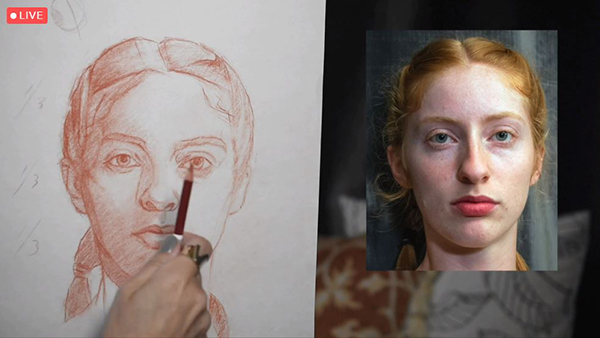
Enjoy a recap of Realism Live, the world’s first global virtual art conference, with these special moments, painting and drawing tips from the masters, Cocktail Hour Paint Along highlights, and more.
Realism Live Beginner’s Day Highlights

Yesterday’s Beginner’s Session of Realism Live proved to be just as invigorating as expected. The day began with Eric Rhoads sharing how to make the most of the event, and with Peter Trippi sharing insights about the historic movement of contemporary realism, how it almost died after World War II, and the revival that has taken place in the past 10-15 years.
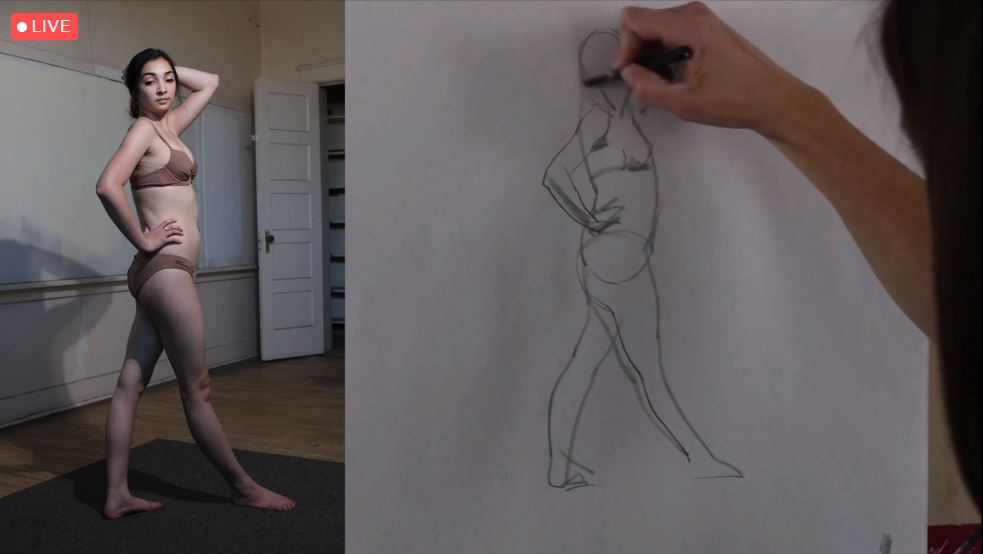
“Drawing is a way to help us better understand what it is we’re looking at,” explained Erin Meads. In her Drawing for Beginners session, Meads demonstrated several gestural sketches, explaining her decisions along the way and including bonus tips on the live chat.
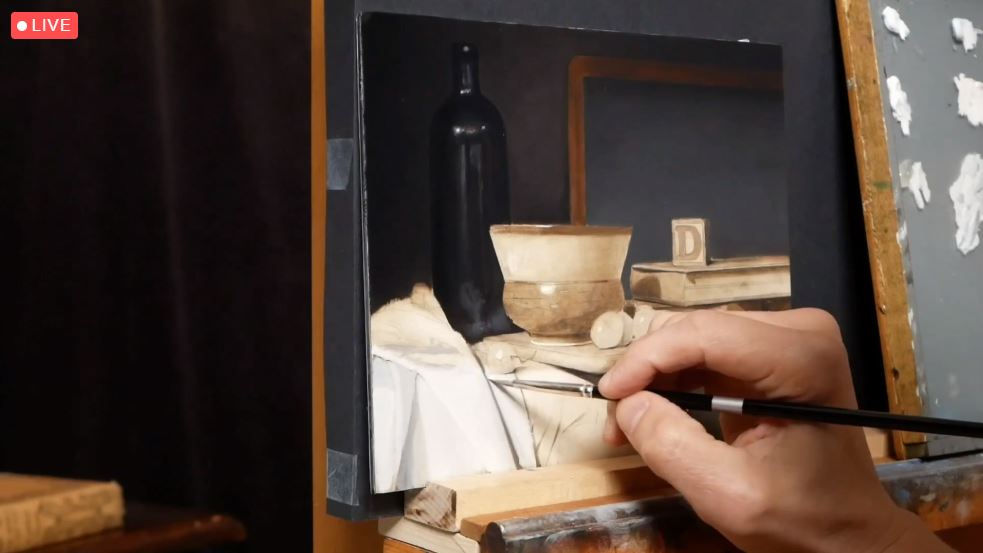
Tony Curanaj shared a color study demonstration of an oil still life. “Everything we look at is just an interpretation,” he said, adding advice such as:
- “The underpainting can be anything…even white canvas. Just don’t get tricked by the white value early on as you make value marks.”
- “Don’t rush. Take your time and love the time you’re learning.”
- “Being curious is very important to being an artist. There is no secret info that will tell you everything. It’s about gathering as much info as possible at different levels.”
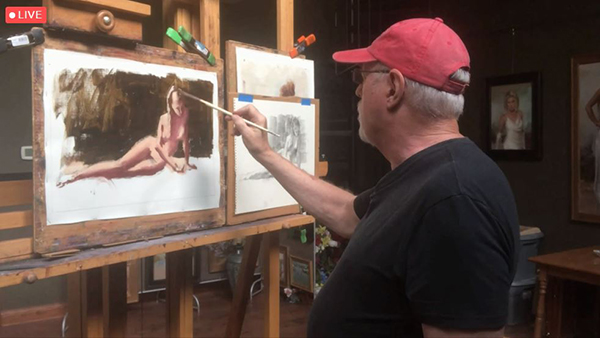
“Painting is easier than we think it is when we start, if you follow a sequence,” said William A. Schneider. In his demo, he showed us how he creates basic shapes and angles first, and then adds more of a drawing aspect when he’s painting the figure. He explained that he tones the canvas, does a charcoal drawing, adds shadows, half-tones, details…and then, “It’s Miller Time.”
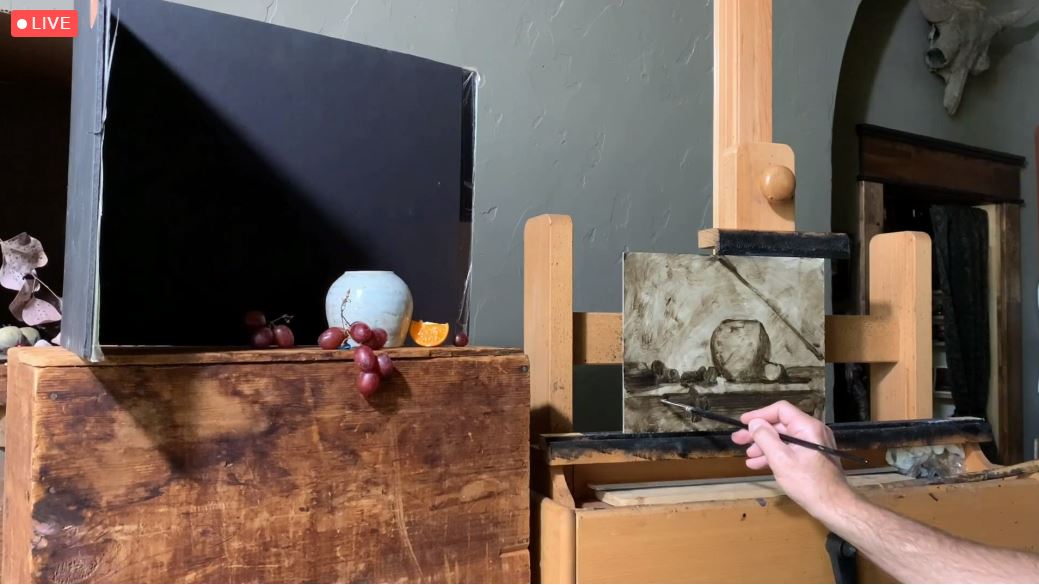
Do not try to imitate a photograph. This concept is one that Jeff Legg said is perhaps the most important part of his lesson on the basics of starting a still life painting. Legg also said to always be working from big shapes to smaller shapes, and to think about painting shapes, not objects. “Keep it very simple in the beginning,” he said.
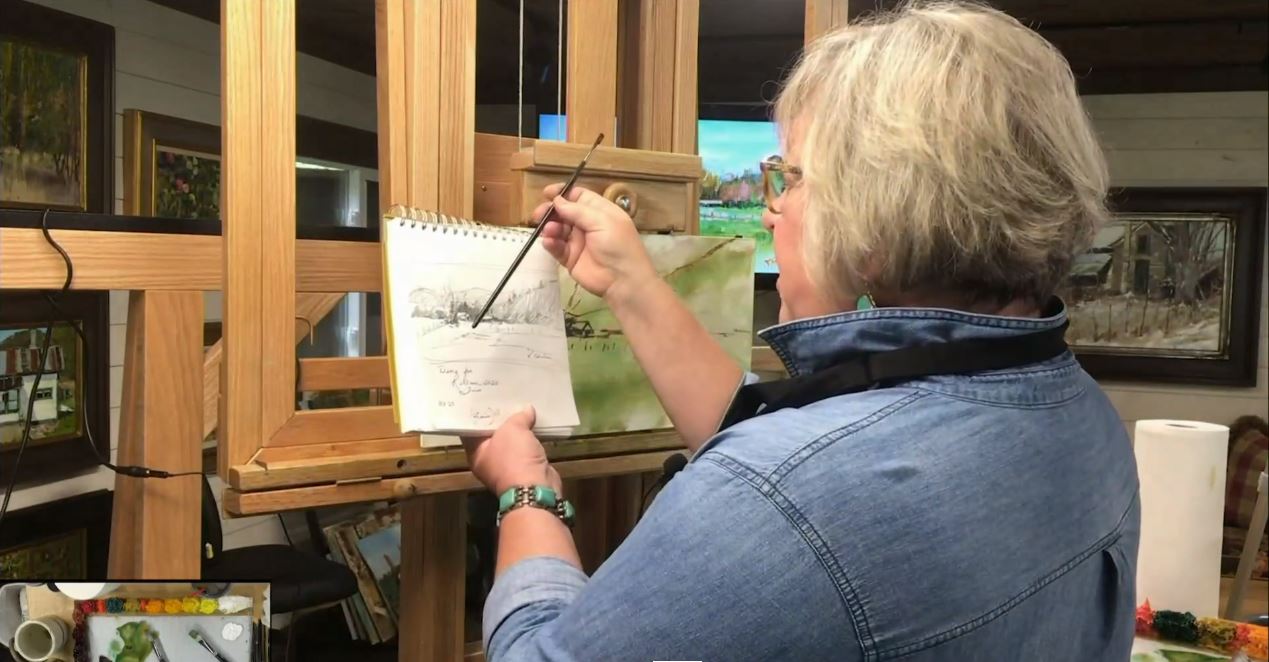
Everyone loved Kathie Odom‘s personality and teaching style. During her “Painting Landscapes” session, she answered many questions in the live chat, explaining the concepts in practical terms.
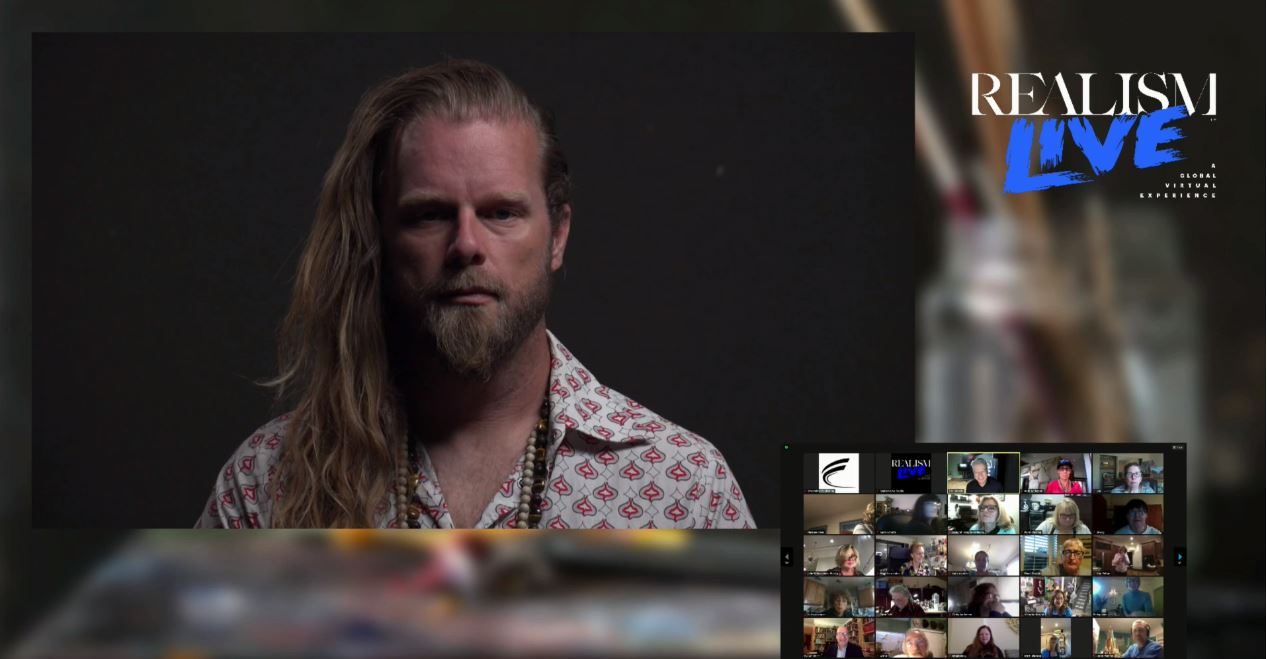
Lots of people joined together for the cocktail party and Paint Along, including some international artists who stayed for just a bit and then reluctantly said goodbye since it was in the middle of the night for them. Above is the model everyone painted – follow #RealismLive on Instagram to see some of the resulting paintings.
Realism Live Day 1 Highlights

Joshua LaRock, who is internationally recognized as a preeminent figurative artist, began Day 1 with sharing insights on drawing and painting the eye. Why so specific? “No matter the subject matter, if there’s an eye it’s probably the most important part of the composition,” he said.
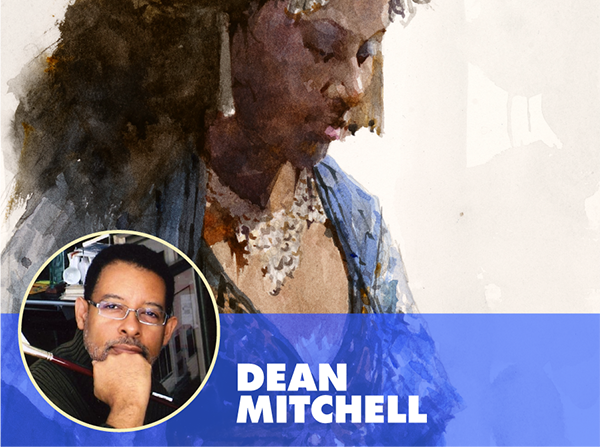
The Florida-based watercolorist Dean Mitchell is admired worldwide for his compelling figurative works, landscapes, and still lifes. In his conversation with Peter Trippi, Mitchell revealed what he has been doing this extraordinary year and how he sees the future of realist art shaping up as we plan life post-pandemic. His comments on the importance of the arts and arts education to society were particularly eye-opening.
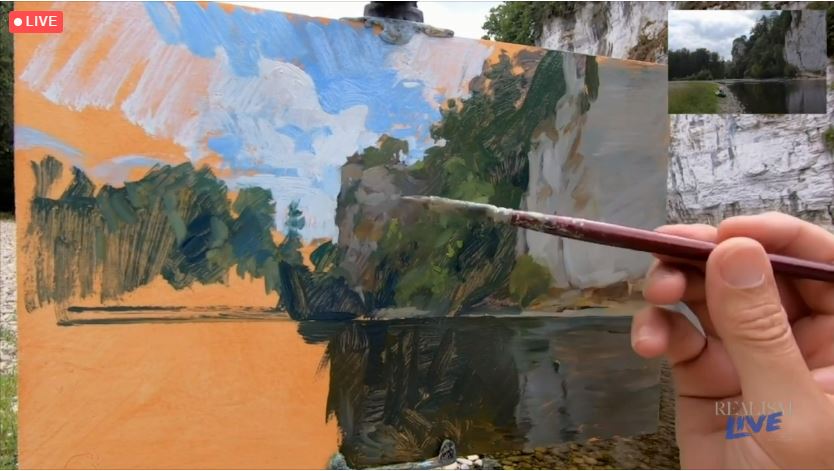
Marc Dalessio took us kayaking on a beautiful river in France, where he set up his easel to explain how to paint landscapes on location using the sight-size method. Dalessio tones his canvas to mimic the wood of an old cigar box because he likes the warm wood color, and advises us to “Err on the side of beauty — if you are making it wrong, make it wrong in a way that is more elegant.”

Three gifted realist artists — Patricia Watwood, Jennifer Balkan, and Alia El-Bermani — have given much thought to the challenges and opportunities that face women in this ever-changing field. In their conversation with Peter Trippi, they explored important topics ranging from gender bias to imposter syndrome and the balance to be struck between work and family life.

When painting during his still life demo, Todd Casey explained that he’s constantly asking himself questions like, “How important is this element? What is it serving? Is it helping to tell the story?” His advice is to not be afraid to remove any given element if you believe it would strengthen the piece to do so.
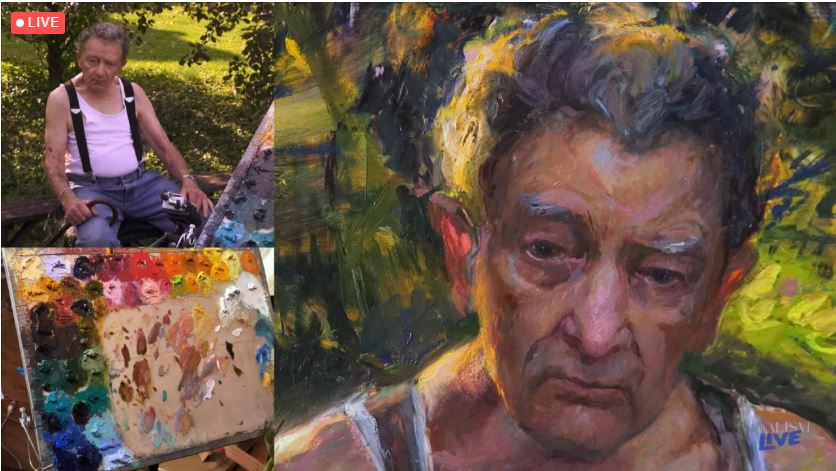
In her quest for a thick, 3D, layered painting, Rose Frantzen demonstrated with oil sticks over oil paint. Frantzen’s father, Wayne, served as her model. When you watch the replay, you’ll see that Frantzen “thinks out loud” and talks viewers through each detail as she continued the demonstration. You’ll even hear her speaking positive self-talk so she stays motivated and forgiving of herself — a good lesson for all of us!
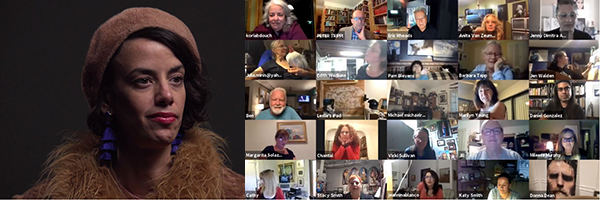
Cocktail Hour included a live action model who sat for a portrait painting session while Eric Rhoads and Peter Trippi had entertaining conversations with many of the days world-wide attendees. (Look closely and you’ll even see that someone’s feathered friend joined us for the call!)
Realism Live Day 2 Highlights
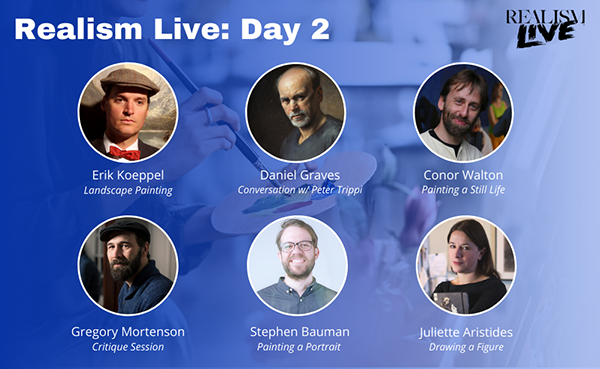
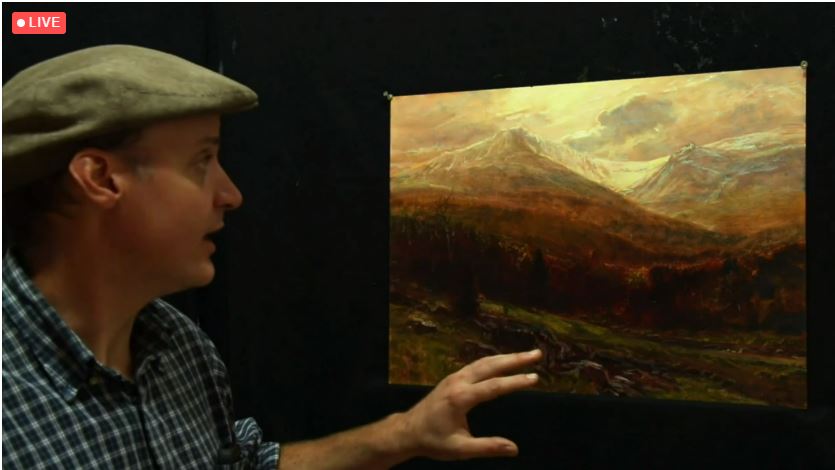
Erik Koeppel is a traditional landscape painter who has become a leader in the revival of the techniques and philosophy of the Hudson River School. In his Realism Live demonstration, he showed everyone how to put the finishing touches on a painting in order to bring it to completion.
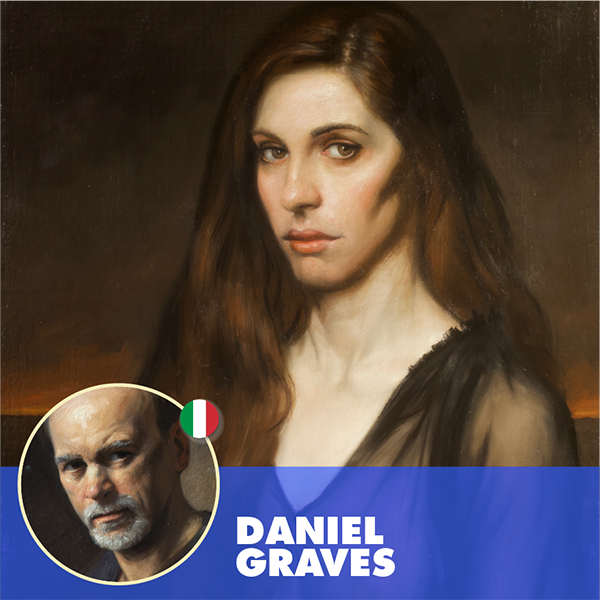
Florence Academy of Art founder Daniel Graves is renowned for his art, and for creating an institution that has trained hundreds of realist artists now working around the world. In his conversation with Peter Trippi, Graves highlighted the ideas and images that matter most to him, helping us understand how historical masters and masterworks can inform everything we do today. A special treat was seeing the interior of his studio in Florence, including the cabinet of pigments he ground himself.

Irish artist Conor Walton gave an in-depth oil painting demonstration, teaching the ins and outs of pigments, including the different qualities and characteristics of the color black, and the importance of understanding its significance.
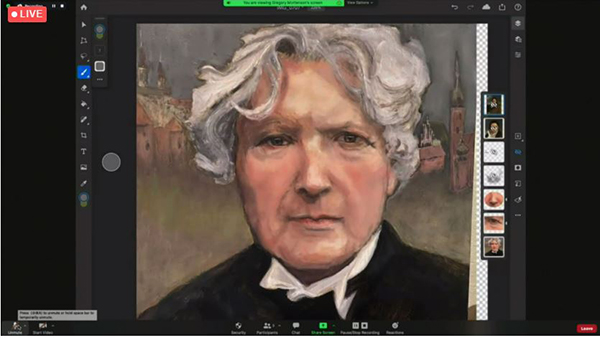
Classically trained artist Gregory Mortenson critiqued nine audience-submitted paintings, using Photoshop to point out basic principles that everyone can apply, including the use of light and shadows, values, and more.

Figurative artist Stephen Bauman took us through every stage of a portrait painting, from the graphite drawing to the refined finished painting. Bauman ended his presentation with these three important pointers:
1. A really good drawing is the key to making a proficient portrait painting.
2. Organization – in regards to your palette, materials, and general preparation – is an enormous part of learning.
3. The ideas and tools you learn about throughout your art studies are open to your interpretation.
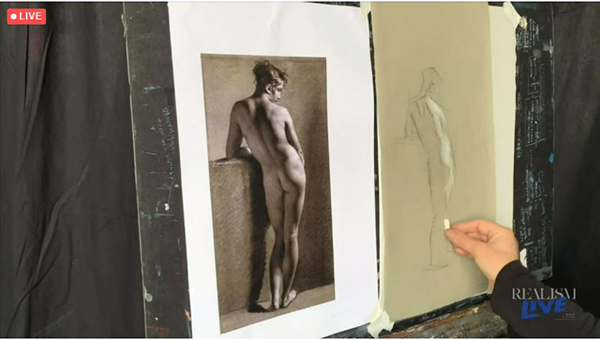
Juliette Aristides, founder and director of the Aristides Atelier at the Gage Academy of Art, led a charcoal figure drawing demonstration. She began by copying a master work to demonstrate how you can learn from existing drawings when you don’t have a model available. Later in the session, she drew from a live model, explaining her choices in mark-making along the way.

Above: Our Day 2 Cocktail Hour / Paint Along live model (left) and one of the resulting works, by Annie Fu (right). Follow the hashtag #RealismLive on Instagram for more scenes from this week.
Realism Live Day 3 Highlights
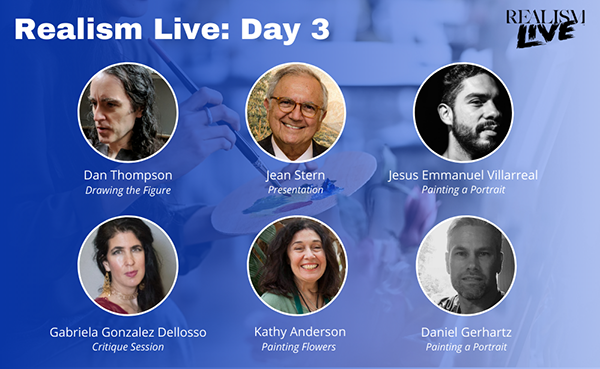
Day 3 of Realism Live began with a pre-show from Royal Talens‘ Director of Art Education Jeff Olson, who gave a seminar on the working properties of oils vs. acrylics. Olson demonstrated the mediums, gave advice, and took questions from the audience.
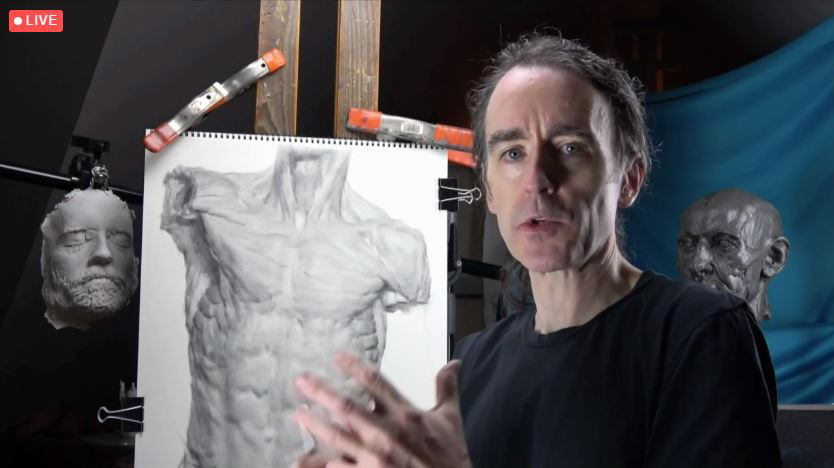
Dan Thompson, Dean of Faculty and Students at Studio Incamminati, led an anatomical figure drawing demonstration that honored the “extraordinary nature of the human form.” He advised that “‘drawing as you feel doesn’t mean anything until you understand your visual language.”

A recognized authority on California Impressionism, art historian Jean Stern gave a fascinating presentation on the history of Realism in art from BC to modern times. He explained how specific paintings over the years have shown representations of everyday activities, religious symbolism, and the nude figure. The takeaway? We’re fortunate to be in a time in which we can learn from living masters today.

The kind and encouraging Jesús Emmanuel Villarreal demonstrated what viewers couldn’t believe Villarreal called a sketch. Many thought it was the full painting and were surprised to hear this was just a starting point. As the piece came together, the audience described it as beautiful…sensitive…and museum-worthy.
In the end, many viewers commented how inspired they are to become better at drawing as they fulfill their dreams of getting better at painting.
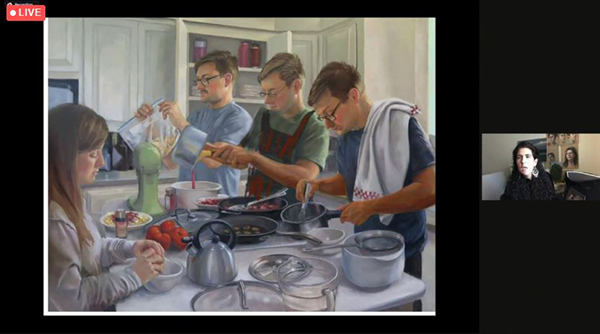
In a critique of audience-submitted paintings, Gabriela Gonzalez Dellosso offered constructive feedback on a variety of topics ranging from shadows to symmetry – from figures to foliage. The audience appreciated the critiques and shared in their comments how much these sessions have helped them see small things that make a big difference in the quality of a painting.
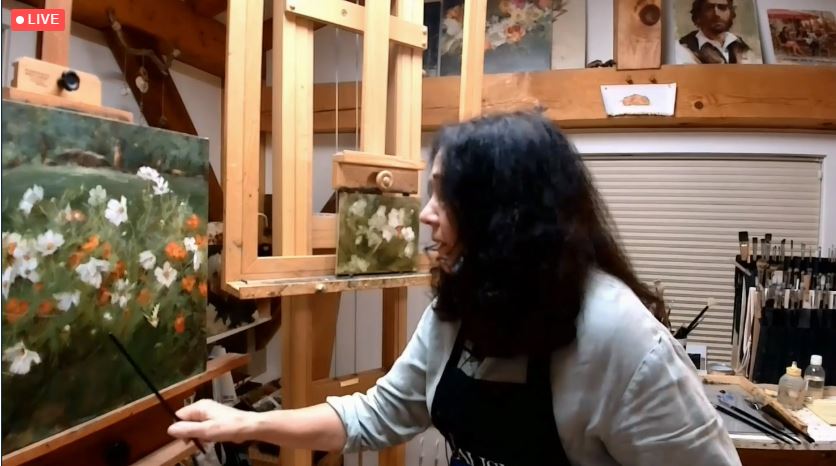
Kathy Anderson is best known for her unique interpretation of flowers, gardens, and intimate landscape scenes. In her energetic Realism Live demonstration, her passion came through to everyone. She explained that if viewers were to “get anything out of this,” it should be that she can draw. Why is this so important? Because having basic drawing skills will make painting much easier for you. Don’t think you can draw well? Rest assured, she reminded us, that “drawing is a skill that can be learned.”

Dan Gerhartz‘s subjects evoke a timelessness and idealism, yet for the most part he has drawn upon his home and community in Wisconsin, including family and friends. His model for this Realism Live session is one he has worked with for about 30 years. In this demonstration, Gerhartz explained how to go into a portrait with the right mindset and how to set yourself up for success from the start of the painting.
“Dan is an excellent teacher; for anyone who has never studied under him I encourage you to do so,” said one viewer. “Not only is he generous with his knowledge, but he is also empathetic and understanding.”
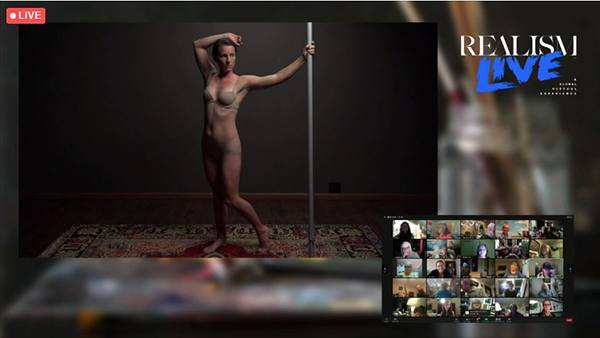
Our Paint Along for Day 3 included the above figure painting / drawing model and the Cocktail Hour, which we’ve all come to look forward to. There, we chat about our favorite parts of the day at Realism Live, as well as deeper topics about our personal artistic journeys. It’s an important way for us to connect with other artists with shared interests, no matter where we’re from.
Realism Live Day 4 Highlights
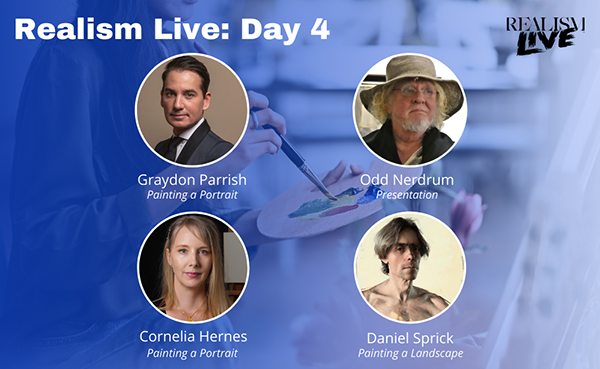
On Day 4 of Realism Live, Pierre Guidetti, a “tireless advocate for the arts” and owner of Savoir Faire, joined us for a pre-show seminar. There, he answered some of the most common questions about oil sticks.
We’d like to give a big thank-you to all of our Realism Live sponsors!
- Platinum Sponsors: Artwork Archive, Laguna Plein Air Painters Association, Royal Talens, Savoir Faire
- Gold Sponsor: Ancient Earth Pigments
- Silver Sponsors: Bristle Magic, Golden Artist Colors
- Organization Partners: American Women Artists, Art Renewal Center, California Art Club

For Graydon Parrish’s demo, the Streamline studio welcomed a museum-borrowed Bouguereau portrait to copy. Parrish explained each of his choices, including how he uses the Munsell color theory and how he relies on understanding the concept of form to create a classical portrait painting. “Take the time to think critically about everything you’re doing,” he said, “and remember that everything is fixable.”

Peter Trippi’s lecture “Where Does Contemporary Realism Go from Here?” laid out the full spectrum of obstacles and opportunities that face our booming field during this exceptional year. (If you’re catching the replay, you may be surprised to learn what worries him the most.) Particularly urgent, in his view, is the need for realist artists to tell the world what’s on their minds; you have the technical skills, so what do you want to say with them now?
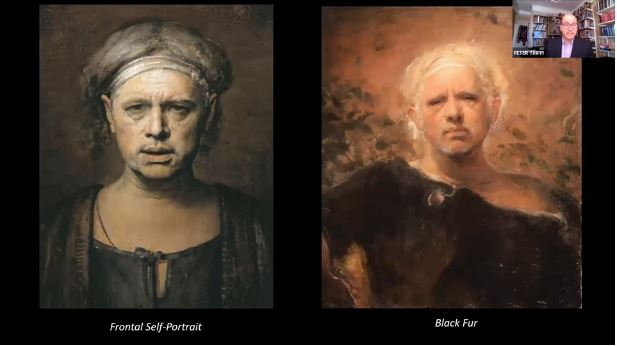
Although Norwegian figurative painter Odd Nerdrum has been an art world outsider for his entire career, he offered Realism Live participants an insightfully a philosophical presentation including thoughts on Aristotle versus Kant, the “art police,” how art should change the world to be a better place, and more. Always featuring his superb draftsmanship and brushwork, Nerdrum’s scenes possess an ethereal, even unearthly, quality, set in a symbolist universe of his own imagining.

Cornelia Hernes started her portrait demonstration by using a digital highlight line to look at the curves and angles of the painting as well as looking at shadows. She then drew beginning lines to show the rhythm and movement of the piece. Alternating between regular video speed and high speed, Hernes walked the audience through every phase of the painting.
In response to questions from the audience, Hernes said she brainstorms a lot of poses before deciding on one. When composing still life, it can be hours or days before she decides.

Contemporary realist painter Daniel Sprick showed us how to make subtle changes to “shift” a building in a painting composition during part of his demo. “I’m interested in all walks of life, everyone,” the artist once explained about his choice of portrait subjects. “Some that may be considered conventionally beautiful and others that may not, and everyone in between.”
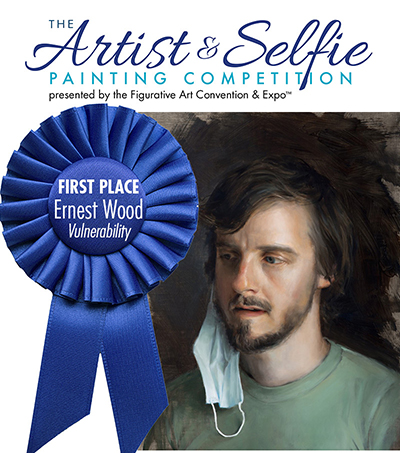
We wrapped up Realism Live with a final Cocktail Hour (including a costume party!) and a special awards ceremony where we announced the finalists and top winners in The Artist & Selfie Painting Competition – watch the full presentation of the winners, who won a total of $44,000 in cash and prizes on our Fine Art Connoisseur magazine Facebook page.
Next up is Watercolor Live! We hope to see you there!


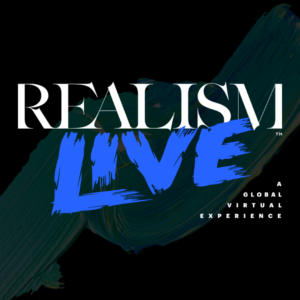




[…] in an ongoing chat room with all the viewers, and nightly Cocktail Hours and Paint Along sessions. Read the full recap of Realism Live here, and keep scrolling down from some favorite […]
Is it possible to view recorded sessions of the artists’ demonstrations? I am a realist artist living in Israel. I have been trying to keep up with the contemporary realist traditions. I look forward to your reply.
Hello, Jeffrey! I’ve shared your message with our customer service team; they’ll be in touch soon to let you know if it’s still available to access. Thank you for checking, and happy painting!
Comments are closed.